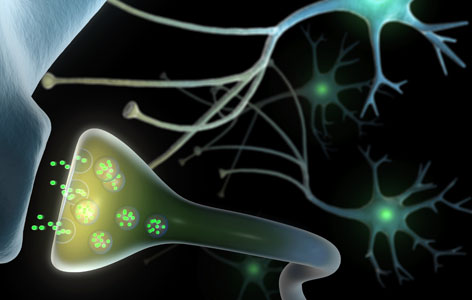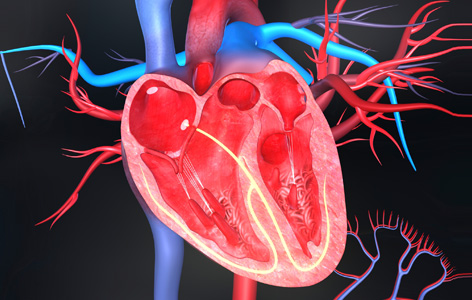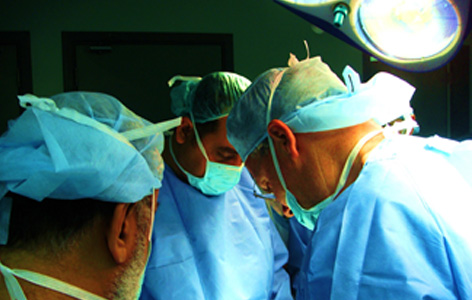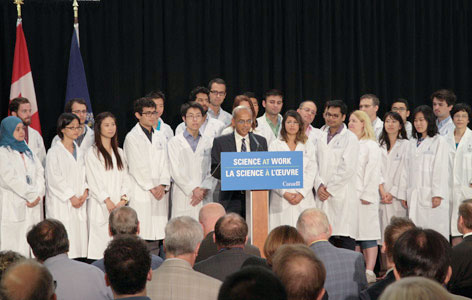 As UHN's monthly research newsletter, NRx reports on the full spectrum of research from UHN's five research institutes: the Princess Margaret (PM) Cancer Centre, the Toronto General Research Institute (TGRI), the Toronto Western Research Institute (TWRI), the Toronto Rehabilitation Institute (TRI) and the Techna Institute (Techna).
As UHN's monthly research newsletter, NRx reports on the full spectrum of research from UHN's five research institutes: the Princess Margaret (PM) Cancer Centre, the Toronto General Research Institute (TGRI), the Toronto Western Research Institute (TWRI), the Toronto Rehabilitation Institute (TRI) and the Techna Institute (Techna).
In this issue you can read about:
- How a surgical treatment for Parkinson disease relieves side effects
- An automated job coach that helps workers overcome disabilities
- How promoting blood vessel growth may prevent heart failure
- New insights into how surgeons balance risk
- How lung transplantation can still benefit older patients
- A new way to study bile duct disorders in the laboratory
- A landmark funding announcement for regenerative medicine research
We hope that you will find NRx informative. If you have feedback or questions, please contact www@uhnresearch.ca.
Christopher J. Paige, PhD, FCAHS
Vice President, Research
University Health Network
Deep brain stimulation offers help to those with the most advanced stages of the disease

Brain plasticity—the strengthening and weakening of neuronal connections—occurs at the synapse (pictured) in response to the release of neurotransmitters such as dopamine (green dots).
Parkinson disease is a movement disorder that causes rigidity, slowness of movement and uncontrollable shaking. Those with advanced stages of the disease experience debilitating symptoms that can lead to difficulty walking and, in some cases, dementia.
The disease is primarily caused by a drop in the amount of dopamine produced by certain cells (neurons) in the brain. The most common therapy, a drug known as levodopa, helps to reduce symptoms by restoring levels of dopamine. Unfortunately, after prolonged use, levodopa can cause rapid fluctuations in responses and complications such as excessive, uncontrolled movements.
For those that have developed levodopa-related side effects, an emerging therapy known as deep brain stimulation (DBS) has been shown to offer relief. While the therapy involves stimulating certain regions of the brain with implanted electrodes, researchers have not yet determined how it works.
TWRI Senior Scientist Dr. Robert Chen has now provided new insight into DBS. His team found that a certain type of brain plasticity, which is compromised in those who suffer from Parkinson disease and advanced levodopa-related side effects, is restored in those that respond to DBS.
The finding suggests that restoration of brain plasticity (ie, the ability of the brain to reshape neural connections), which is required for learning and memory, may be how deep brain stimulation provides beneficial effects to Parkinson patients. Comments Dr. Chen, "This new understanding of the mechanism by which deep brain stimulation works may pave the way for more specific and targeted therapies."
This work was supported by the Canadian Institutes of Health Research and the Toronto General & Western Hospital Foundation. R Chen holds the Catherine Manson Chair in Movement Disorders. AM Lozano holds a Tier 1 Canada Research Chair in Neuroscience.
Effects of subthalamic nucleus stimulation on motor cortex plasticity in Parkinson disease. Kim SJ, Udupa K, Ni Z, Moro E, Gunraj C, Mazzella F, Lozano AM, Hodaie M, Lang AE, Chen R. Neurology. 2015 Jul 8. [Pubmed abstract]
Responsive prompting system enables those with cognitive disabilities to perform tasks at work

Those with intellectual disabilities are often underemployed, which negatively impacts their quality of life.
Doing a job well and earning wages is a source of empowerment and self-esteem, especially for those with intellectual or developmental disabilities. This group of people has the lowest employment rate, and often require assistance to complete jobs with complex directions or where tasks can vary depending on what is happening in the work environment.
TRI Senior Scientist Dr. Alex Mihailidis and colleagues developed an automated system to help guide workers through a multi-step assembly task and reduce the burden on human job coaches. The system—called nonlinear contextually aware prompting system (N-CAPS)—uses a camera and advanced analysis techniques to determine the progress of the worker in the assembly task. When workers pause, or perform a step incorrectly or out of order, the system prompts them and provides instructions via a touchscreen tablet that displays an animated job coach. "The heart of the N-CAPS solution is the decision-making module that identifies the most appropriate course of action: whether a prompt is required, and the type of prompt that should be given," explains Dr. Mihailidis.
The N-CAPS system was examined in a pilot study and the researchers found that it did increase the abilities of the participants to perform tasks without the need for a human job coach. However, it also exposed weaknesses in the wording of prompts, which the researchers will address before moving on to more extensive studies of the N-CAPS system. "This type of technology could help workers with cognitive disabilities lead an active and independent life," concludes Dr. Mihailidis.
This work was supported by the University of Colorado Rehabilitation Engineering Research Center for the Advancement of Cognitive Technologies, the National Institute on Disability and Rehabilitation Research and the Toronto Rehab Foundation. A Mihailidis holds the Barbara G. Stymiest Chair in Rehabilitation Technology Research.
A nonlinear contextually aware prompting system (N-CAPS) to assist workers with intellectual and developmental disabilities to perform factory assembly tasks: system overview and pilot testing. Mihailidis A, Melonis M, Keyfitz R, Lanning M, Van Vuuren S, Bodine C. Disability and Rehabilitation Assistive Technology. 2015 Jul 1. [Pubmed abstract]
A protein that regulates blood vessel growth may help to prevent heart failure

Hypertrophy increases the thickness of the heart muscle without increasing the number of blood vessels. This leaves some parts of the heart without sufficient oxygen.
The heart maintains normal blood circulation by pumping blood into the arteries. Increased resistance against the flow of blood, which occurs in individuals with high blood pressure, requires the heart to pump harder to keep the blood circulating. To compensate for the increased work, heart cells must increase their size through a process known as hypertrophy. This compensatory mechanism can maintain heart function for a short period of time; however, if high blood pressure persists, the enlarged heart cells outgrow their blood supply. Without the required increase in blood vessel growth, the heart cells die causing irreversible damage to the heart that eventually leads to heart failure.
Increasing the number of blood vessels in the hypertrophic heart has been shown to halt the progression to heart failure by providing vital oxygen to injured heart tissue. With this in mind, TGRI Scientist Dr. Ren-Ke Li examined the role of a new protein known as Canopy2, which was recently identified as a blood vessel growth factor. Dr. Li and his team discovered that boosting levels of Canopy2 in the heart could stimulate blood vessel growth, preserve heart function and prevent the structural changes leading to heart failure.
Explains Dr. Li, "We think that Canopy2 decreases the activity of a protein called p53, which is known to inhibit blood vessel growth. This may explain why Canopy2 is able to prevent the cell death that normally occurs in response to severe stress. It also suggests that Canopy2 could potentially contribute to preventing heart failure."
This work was supported by the Canadian Institutes of Health Research, the Toronto General & Western Hospital Foundation and the McEwen Centre for Regenerative Medicine. R-K Li holds a Tier I Canada Research Chair in Cardiac Regeneration.
Canopy 2 attenuates the transition from compensatory hypertrophy to dilated heart failure in hypertrophic cardiomyopathy. Guo J, Mihic A, Wu J, Zhang Y, Singh K, Dhingra S, Weisel RD, Li RK. European Heart Journal. 2015 July 9. [Pubmed abstract]
Understanding a surgeon's own unique assessment of risk offers new strategies for training

On an individual level, surgeons monitor their own performance while continuously assessing the limits of their own competence.
Because surgery is associated with inherent risk and potential harm to patients, risk has been examined in terms of system-wide factors as well as those based on factors relating to the personality and perspectives of surgeons. Yet, how individual surgeons negotiate risk, perceive it and make decisions to accept or reject risk, remains poorly understood. A study, led by PM Cancer Centre CCRU member and Wilson Centre Scientist Dr. Carol-anne Moulton and conducted by her student Nathan Zilbert, sheds light on this important subject.
The team conducted interviews to explore individual surgeons' perspectives on risk in the context of their comfort zones (when a surgeon is feeling competent and capable of managing the risk that is inherent to a case). These interviews revealed that when surgeons perceived cases to be at the boundary of their comfort zones, they adjusted their decision-making based on patient and environmental factors, and these often led to modifications of the environment with the goal of bringing the case back within their comfort zones. For example, in one case a surgeon who provided coverage at multiple hospitals described how she would only operate on patients at her base hospital, where she had access to the right team that could handle the procedure and optimize outcomes for the patient. By moving the patient to a hospital where she felt confident in the abilities of the surgical team, the surgeon was able to modify the environment so that she felt capable of managing the risk associated with the case.
"The comfort zone concept provides a framework for understanding how expertise and judgement develops for a surgeon in training," says Dr. Moulton. "This could help them better understand their own risk assessments when functioning independently in the teaching environment and ultimately when in practice."
This work was supported by a Studies in Medical Education Fellowship from the Royal College of Physicians and Surgeons of Canada (for NR Zilbert), and The Princess Margaret Cancer Foundation.
Taking a chance or playing it safe: reframing risk assessment within the surgeon's comfort zone. Zilbert NR, Murnaghan ML, Gallinger S, Regehr G and Moulton C-A. Annals of Surgery. 2015 Aug. [Pubmed abstract]
Patients over 60 experience significant improvement in quality of life after transplantation

In 2011, half of the lung transplant recipients in an international registry were over the age of 56.
A lung transplant is a surgical procedure in which a damaged lung is replaced with a healthy lung from a deceased donor. To make the best use of the limited availability of donor lungs, appropriate selection criteria are needed to identify patients who are most likely to benefit from a transplant.
Older patients are less likely to be eligible for transplantation because they may have other health problems and a shorter life expectancy after the procedure; however, a recent UHN study suggests that a person's age alone should not prevent them from receiving a lung transplant.
The study, led by TGRI Clinical Researcher Dr. Lianne Singer, included 326 lung transplantation recipients, of which over 100 were 60 years of age or older. Those who participated in the study completed five different questionnaires evaluating their health-related quality of life before transplantation and up to five years after. By analyzing participants' responses to the questionnaires, researchers discovered that younger and older recipients experienced similar improvements in their quality of life.
"Our findings suggest that the age of a transplant candidate should only be considered in conjunction with other health factors. Age alone does not determine how much a person will benefit from the transplant. Moreover, our findings will enable physicians to provide better information to transplant candidates and their families about what to expect after the procedure." says Dr. Singer.
This work was supported by the Canadian Institutes of Health Research, the Physicians' Services Incorporated Foundation, the Canadian Lung Transplant Study Group, the University Health Network Multi-Organ Transplant Program, Ontario Lung Association-Pfizer Canada and the Toronto General & Western Hospital Foundation.
Effects of recipient age and diagnosis on health-related quality of life benefit of lung transplantation. Singer LG, Chowdhury NA, Faughnan ME, Granton J, Keshavjee S, Marras TK, Tullis DE, Waddell TK, Tomlinson G. American Journal of Respiratory and Critical Care Medicine. 2015 July 1. [Pubmed abstract]
Regenerative medicine researchers find a new way to turn stem cells into bile duct cells

Bile duct disorders often lead to a buildup of bile in the body, causing jaundice—a yellow discolouration of the skin and eyes (pictured).
Bile ducts are structures in the liver that transport bile—a substance that helps with digestion. The ducts are lined with cells called cholangiocytes; when these cells malfunction, liver damage occurs often resulting in the need for a transplant. Although bile duct disorders are well-recognized causes of liver disease, the events leading to cell malfunctioning are not fully understood due to the lack of suitable experimental models.
For the first time, a research team led by Drs. Anand Ghanekar (TGRI Affiliate Scientist), Gordon Keller (PM Cancer Centre Senior Scientist and McEwen Centre Director), Shinichiro Ogawa (McEwen Centre postdoctoral fellow) and Binita Kamath (SickKids Research Institute) has developed a robust tool to study bile duct cells. The researchers demonstrated a method to produce cholangiocytes from human stem cells, based on providing the stem cells with certain activators (known as NOTCH, EGF, HGF or TGFβ) at specific times during the production process. Although the cells are cultured in a laboratory dish, the procedure allows them to naturally form three-dimensional ducts that perform cholangiocyte-related functions.
"This method enables us to compare cholangiocytes from people with abnormal bile ducts to those from people with normal tissues," says Dr. Ghanekar. "This way, we can uncover what leads to cholangiocyte malfunctioning and develop new therapies for those with bile duct disorders like cystic fibrosis."
Dr. Ogawa adds, "This study complements our previous work that identified a method to generate liver cells from the same stem cells. In addition to helping develop drugs, we now have the essential building blocks to begin engineering functional human liver tissue."
This work was supported by the McEwen Centre for Regenerative Medicine; the Canadian Institutes of Health Research; the University Health Network Multi-Organ Transplant Program Academic Enrichment Fund; the Alagille Syndrome Alliance; the SickKids Research Institute; the Rare Disease Foundation; the Childhood Liver Disease Research and Education Network; the National Institute of Diabetes, Digestive and Kidney Diseases; The Princess Margaret Cancer Foundation; and the Toronto General & Western Hospital Foundation. G Keller is a Tier 1 Canada Research Chair in Embryonic Stem Cell Biology.
Directed differentiation of cholangiocytes from human pluripotent stem cells. Ogawa M, Ogawa S, Bear CE, Ahmadi S, Chin S, Li B, Grompe M, Keller G, Kamath BM, Ghanekar A. Nature Biotechnology. 2015 July 13. [Pubmed abstract]
Historic $114 million award aims to harness Canada's strengths in regenerative medicine

University of Toronto Vice President Research Professor Vivek Goel addresses the audience at the Canada First Research Excellence Fund announcement while trainees look on.
University of Toronto stem cell researchers were recently awarded a grant worth an unprecedented $114 million that is aimed at helping them translate their promising research discoveries into more effective therapies for patients in Canada and worldwide. It is one of five projects that will receive funding under the inaugural Canada First Research Excellence Fund program competition, which was launched by the federal government in 2014.
The initiative, which is led by McEwen Centre Researcher Dr. Peter Zandstra and titled Medicine by Design, has strengths in multiple disciplines and draws from research institutions, businesses and organizations across Canada, including the University Health Network's McEwen Centre for Regenerative Medicine, the Ted Rogers Centre for Heart Research and the Centre for Commercialization of Regenerative Medicine. The grant's three research pillars aim to create: safer and more effective stem cell-based therapies; complex tissues for research, drug discovery and replacement of damaged tissues; and organs that can be successfully transplanted into human patients.
Dr. Zandstra explains, "Stem cells offer avenues to treat–and perhaps cure–devastating and costly illnesses such as cardiovascular disease, diabetes, blindness, lung disease, neurodegenerative disorders, and diseases of the blood and musculoskeletal system. Medicine by Design provides a framework to design the cells, the materials and, ultimately, the clinical strategy needed to reach this goal."
 Dr. Mary Gospodarowicz was named an Officer of the Order of Canada for advancing and improving cancer radiotherapy and for her leadership in cancer care around the world.
Dr. Mary Gospodarowicz was named an Officer of the Order of Canada for advancing and improving cancer radiotherapy and for her leadership in cancer care around the world.  Dr. Jay Keystone was appointed as a Member of the Order of Canada for his expertise as a clinician and educator within the discipline of tropical and infectious disease.
Dr. Jay Keystone was appointed as a Member of the Order of Canada for his expertise as a clinician and educator within the discipline of tropical and infectious disease.  Dr.
Dr.  TWRI Senior Scientist Dr.
TWRI Senior Scientist Dr.